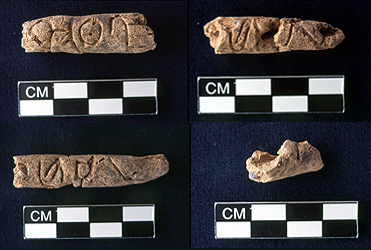The Signs from Umm el-Marra
Updated 27 Oct 2006
Below are the main images and the (scanty) text in Schwartz et al. on recent symbol finds from Umm el-Marra, Syria. Below that, I’ve also included better color photos from the excavation website.
Extracted on 27 October 2006 from:
“A Third-Millennium B.C. Elite Mortuary Complex at Umm el-Marra, Syria: 2002 and 2004 Excavations”,
Glenn M. Schwartz, Hans H. Curvers, Sally S. Dunham, Barbara Stuart, and Jill A. Weber,
American Journal of Archaeology 110 (2006): 603-41.
Download paper (PDF view-only version):
A Third-Millennium B.C. Elite Mortuary Complex


My first take on these materials: They look much like other members of a broad class of deity/ritual/clan, etc., symbols used widely in third-millennium Eurasia. The fact that these are associated with what appear to be royal graves would make it seem likely that they had some kind of ritual meaning.
It stretches credulity given the scanty evidence for the authors to suggest (as they do above without discussion) that these symbols are part of a “non-cuneiform writing system.” The suggestion that the authors probably don’t know much about scripts or symbols is apparent from the note in which they thank another researcher for pointing to possible links to “vessel ‘pot marks’ found in this period.”
It is easy to find superficial resemblances between a few of these signs and those in other third-millennium sign systems, including proto-cuneiform, proto-Elamite, symbols from Shahdad, and Indus signs, etc. The ease of making identifications like this is well-known, as are some of the reasons why we make them. (Among other things, we know that many similarities exist in the forms of pictographic signs world-wide).
Before wasting time imagining such links with other sign systems based on the article’s drawings, note the authors’ comments that the two lower pieces — whose drawings aren’t similar — may carry the same signs.
The result is that you can’t make any judgments about the signs using these drawings, which appear to be grossly inaccurate. The small color pictures on the excavation website are a bit better, and bear out the claim in the text that two of the objects carry identical signs:
Johns Hopkins Near Eastern Studies

Four pieces aren’t much to go by, but given what we know today of third-millennium scripts and symbol systems, it’s reasonable to model these inscriptions as further examples of a class of nonlinguistic signs used side-by-side or sometimes instead of writing in much of third-millennium BCE Eurasia. That by itself is important, and I’d be surprised if we didn’t find more systems like this in the future.
Finds of any long strings like this in the future would presumably falsify the thesis that the symbols are nonlinguistic in character. R. Sproat, M. Witzel, and I have said the same about Indus inscriptions.
It should be noted finally, due to vague resemblances of some of these signs to Indus symbols (and to signs in many other symbol systems) that the type of pierced objects on which these Syrian symbols appear don’t show up anywhere in Indus culture. Moreover, no symbol-bearing objects of any sort have ever been associated with Indus burials. But the level of sophistication of these inscriptions appears to be similar to those in the (very distant) Indus region, and that is noteworthy since these inscriptions are roughly coterminous with mature Indus civilization.
Whatever future excavations suggest about these objects, the findings are certain to be important. Testing of the initial thesis that they are nonlinguistic, which I suspect will be verified in future digs, may in fact throw indirect light on the Indus system — by providing further evidence for similar if smaller-scale systems. On the evidence in the Indus case, see Farmer, Sproat, and Witzel, “The Collapse of the Indus-Script Thesis”, 2004.
Feb 2023 format changes from web server migration.
